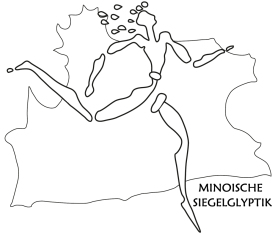Minoan glyptic between traditional recording and 3D-forensic studies: A multidisciplinary documentation of 900 unpublished seals from the Archaeological Museum of Heraklion

The aim of the project is to incorporate a large number of mostly unpublished seals that are kept at the Archaeological Museum of Heraklion into the CMS Series, thereby serving to promote the study of Aegean glyptic. The project is hosted by the Institute of Classical Archaeology in Heidelberg and is carried out in close collaboration with the institutes and excavators that hold the rights to the material. The venture is funded by the German Research Council (DFG) and the Institute for Aegean Prehistory (INSTAP).
Aims
The main objective of the project is to include 900 largely unpublished seals that are kept at the Archaeological Museum of Heraklion into the CMS Series. The seals will be published in a two-volume set and will also be included in the CMS Databases in ARACHNE, which are freely accessible on the internet. With the publication of this material, the CMS will finally offer a complete catalogue of the Aegean seals kept at the Archaeological Museum of Heraklion up until 2016. This significant update will considerably promote current understanding of Aegean glyptic, together with a variety of issues pertaining to Aegean society. Following the standard naming procedure of the CMS, the title of the new volume will be CMS II Suppl.: Iraklion, Archäologisches Museum, Supplementum. Alt- und Neufunde aus Zentral- und Ostkreta.
The project also explores new ways of implementing standard research methods applied to glyptic. Innovative methods taken from physical and computer sciences are employed in an attempt to consider questions relevant to the manufacturing process, the materials employed and the use of Minoan seals from a new perspective. High-resolution close-range 3D-scanning of selected pieces can help reconstruct part of the biography of seals by digitally recreating the tip of manufacturing tools and tracing wear marks. Non-destructive XRF-scanning allows for a fast and accurate definition of the consistency of the seal materials. Issues regarding the localization of mineral deposits and seal workshops may be addressed in a new light using these data in the future.
The project aspires to make Aegean glyptic accessible to a broader interested audience: the non-specialist archaeologist and the general public alike. To this end, the importance of Minoan glyptic for understanding Minoan societies will be discussed in the new volume and a free-online platform with 3D-scans of selected objects will be made available. By adopting English as the official language of the project and by adding short explanatory texts pertaining to stylistic dating for each catalogue entry, the new volume will become more accessible and take on a handbook character.
Concept
The project relies heavily on συνεργασία. The collaboration of project team members in Heidelberg with chosen experts from around the world, archaeological institutes/schools as well as excavators of the seals will serve to promote scholarly exchange and create the appropriate circumstances for a scholarly result of the highest scientific standards. The excavators of the material will be responsible for entries relevant to their excavations and will be signing as co-authors of the volume.
Importance
With more than 12,000 seal faces known today, glyptic represents the richest source of Aegean imagery and provides an image ‘database’ of everyday life and the cognition of the Aegean individual. The sheer number of Aegean seals and ancient seal impressions, which exceeds 10,000 (this itself is estimated to represent only 5% of the original output) is a potent piece of evidence for the significance of seals in Aegean societies. Seals were used as a means of preventing unauthorized access, of identification and substantiation, as personal charms, status symbols and ornaments. The diverse roles of these objects underline their importance at multiple societal levels, starting from the personal one and reaching that of state administration, and thus their significance for understanding the societies that produced them.
The project will set the foundation for the continuation of the CMS Series which has become a standard work of reference for the study of Aegean seals and sealings. The aim of the project team is for it to function as a platform for the creation of a worldwide point of reference for the study of Aegean glyptic and administration in Heidelberg.
Material
It is estimated that the number of pieces to be published in the volume will reach 900. The vast majority of these are seals but a few seal impressions will also be included. The material comes predominantly from find spots in central Crete and ranges in date from EM II to LM III. The earliest seal as regards date of recovery to be published in the volume comes from Arthur Evans’ 1900-1903 Knossos excavations and the most recent from excavations conducted in central Crete in 2016. The reasons why several early finds were not included in previous CMS volumes vary. Some pieces were not known to the editors of the relevant CMS volumes at the time of publication while others were still unpublished at the time of the relevant CMS publication and the excavators could not allow their inclusion prior to their final publication in their own excavation volumes.
Project team
Maria Anastasiadou: Project leader
Dionyssis Antypas: Research assistant
Nasser Ayash: Research assistant
Yuval Goren (Tel Aviv): XRF-scanning
Olga Krzyszkowska (London): Co-editor of CMS II Suppl.
Hubert Mara: 3D-scanning
Diamantis Panagiotopoulos: Project holder
Angeliki Theodoropoulou: Drawings
Diana Wolf: Research assistant
The publication of CMS II Suppl. was originally planned as an undertaking of the CMS in Marburg. A critical amount of preliminary work for the volume was therefore done by the Marburg team, Ingo Pini and Walter Müller, with the support of the Archaeological Museum of Heraklion and its former director Yannis Sakellarakis. Written documentation, photographs and modern impressions of the majority of seals to be published in the volume were therefore already available at the CMS Archive in Heidelberg at the time the project was begun. This material constitutes the core of the new project.

